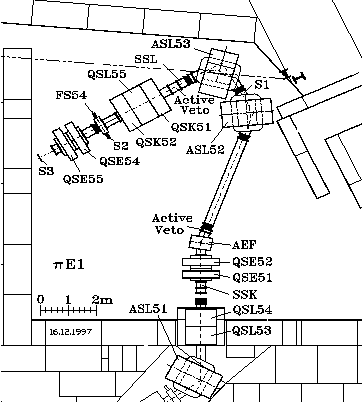



In 1995, soon after the initial KARMEN publication [1], we undertook a first search for the rare decay(1) with the decay-in-flight method. Using the high intensity pion channel pE1 at PSI, we were able to set an upper limit on the branching fraction h of this decay at h < 2.6·10 -8 (95% c.l.) [7]. Recently, we took data as part of a test run for a new experiment, designed to place a more stringent limit on h. This could be achieved by making improvements to the pion-beam definition and background suppression, by using a new beam-line optics, an improved vacuum system, as well as the addition of active and passive collimators.
Our new experimental setup, also at PSI, is shown in Fig.2. The beam-line consists of three main parts: the first part, from the pion production target to the end of the dipole magnet AEF, defines the pion beam phase space, centred-on a momentum of 150 MeV/c with a momentum byte of 1.5% FWHM, the second part is a 4.5 m long field-free region between the AEF and the start of the ASL52 dipole magnet and serves as the decay region, and the final section from the ASL52 magnet to the counter S3 is used as a muon momentum spectrometer.
There are also three scintillation counters S1, S2 and S3 shown, which were
used to define the trigger. A muon scintillator telescope, placed in the
decay region, close to the maximum decay angle for muons from decay(2),
as well as a proton monitor in the primary proton beam were used for
normalization purposes. There were also various sets of active and passive
collimators placed in the vacuum system in order to reduce background of
scattered events.

Figure 2: The beamline consists of three parts: (i) The pion transport channel up to and including the AEF magnet (the standard pE1 elements are not shown). (ii) The pion decay region between the AEF and ASL52 magnets. (iii) The muon transmitting and analyzing section from the ASL52 magnet to the S3 counter.
A pion momentum of 150 MeV/c was chosen to give an optimal TOF-separation for beam particles (p+, m+, e+) between the counters, as well as a reasonable decay-rate in the decay region. From the measured S1 rate we estimate that 2.2 ·107 p+s-1 enter the decay region at a beam current of 1.47 mA, of which 42% decay within this region.


